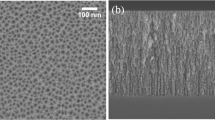Abstract
The compatible carbon-silicon complex materials originated from precursor diglycerylsilane (DGS) and sugar-modified silane N-(3-triethoxysilylpropyl)gluconamide (GLS) have gained substantial popularity by demonstrating admirable properties to stabilize entrapped biomolecules. The microenvironment inside these materials, especially the distribution of sugar moieties inside the matrix, which is likely the most critical factor determining compatibility of these materials, still remains unclear. To deeply investigate the biocompatibility mechanism of these materials, we have adopted two different preparation routes for these materials by introducing GLS into the starting DGS sol stage, but things are different after the DGS gel is formed. A fluorescence probe rhodamine 6G is introduced herein in the DGS sol to monitor the distribution of GLS moieties, as well as the evolution of the microenvironment inside resulting materials. All in all, the findings demonstrated that the timing of GLS addition plays a critical role in controlling the evolution of the inner structure of materials, suggesting that this factor provides a promising route to tune the properties of the resulting materials.
Similar content being viewed by others
References
Besanger T R, Chen Y, Deisingh A K, Hodgson R, Jin W, Mayer S, Brook M A, Brennan J D. Screening of inhibitors using enzymes entrapped in sol-gel-derived materials. Anal Chem, 2003, 75(10): 2382–2391
Cruz-Aguado J, Chen Y, Zhang Z, Elowe N, Brook M A, Brennan J D. Ultrasensitive ATP detection using firefly luciferase entrapped in sugar-modified sol-gel-derived silica. J Am Chem Soc, 2004, 126(22): 6878–6879
Castelvetro V, Devita C. Nanostructured hybrid materials from aqueous polymer dispersions. Adv Colloid Interf Sci, 2004, 108(109): 167–185
Geddes C D, Birch D J. Nanometre resolution of silica hydrogel formation using time-resolved fluorescence anisotropy. J Non-Cryst Solids, 2000, 270(6):191–204
Birch D J S, Geddes C D. Sol-gel particle growth studied using fluorescence anisotropy: An alternative to scattering techniques. Phys Rev E, 2000, E 62(2): 2977–2980
Geddes C D, Karolin J, Birch D J S. Sol-gel nanometrology: Gated sampling can reveal initial sol formation kinetics. J Fluoresc, 2002, 12(1):113–117
Geddes C D, Karolin J, Birch D J S. Fluorescence anisotropy in sol-gels: Microviscosities or growing silica nanoparticles offering a new approach to sol-gel structure elucidation. J Fluoresc, 2002, 12(2): 135–137
Geddes C D. 1 and 2-photon fluorescence anisotropy decay to probe the kinetic and structural evolution of sol-gel glasses. J Fluoresc, 2002, 12(3/4): 343–367
Dina T, Zhang Z, Brennan J D. Evolution of sodium silicate sols through the sol-to-gel transition assessed by the fluorescence-based nanoparticle metrology approach. J Phys Chem B, 2003, 107(37): 10127–10133
Tleugabulova D, Duft A M, Zhang Z, Chen Y, Brook M A, Brennan J D. Evaluating formation and growth mechanisms of silica particles using fluorescence anisotropy decay analysis. Langmuir, 2004, 20(14): 5924–5932
Dina T, Duft A M, Brook M A, Brennan J D. Monitoring solute interactions with PEO modified colloidal silica nanoparticles via fluorescence anisotropy decay. Langmuir, 2004, 20(1): 101–108
Dina T, Zhang Z, Chen Y, Brook M A, Brennan J D. Fluorescence anisotropy in studies of solute interactions with covalently modified colloidal silica nanoparticles. Langmuir, 2004, 20(3): 848–854
Sui J, Tleugabulova D, Brennan J D. Direct and indirect monitoring of peptide-silica interactions using time-resolved fluorescence anisotropy. Langmuir, 2005, 21(11): 4996–5001
Tleugabulova D, Sui J, Ayers P W, Brennan J D. Evidence for rigid binding of rhodamine 6G to silica surfaces in aqueous solution based on fluorescence anisotropy decay analysis. J Phys Chem B, 2005, 109(16): 7850–7858
Baker G A, Jordan J D, Bright F V. Effects of Poly(ethylene glycol) doping on the behavior of pyrene, rhodamine 6G, and acrylodan-labeled bovine serum albumin sequestered within tetramethylorthosilane-derived sol-gel-processed composites. J Sol-Gel Sci Technol, 1998, 11(1): 43–54
Baker G A, Pandey S, Maziarz E P, Bright F V. Toward tailored xerogel composites: Local dipolarity and nanosecond dynamics within binary composites derived from tetraethylorthosilane and ORMOSILs, oligomers or surfactants. J Sol-Gel Sci Technol, 1999, 15(1): 37–48
Author information
Authors and Affiliations
Corresponding author
Additional information
Supported by the National Natural Science Foundation of China (Grant No. 20876176), Scientific Research Foundation for the Returned Overseas Chinese Scholars by the State Education Ministry, Key Project of Chinese Ministry of Education (Grant No. 109100), Doctoral Project of Shandong Province (Grant No. 2008BS09013), Research Foundation of Key Laboratory of Carbon Materials, Institute of Coal Chemistry, CAS (Grant No. KFJJ0506), and Natural Science Foundation of Shandong Province (Grant No. Q2007B02)
An erratum to this article can be found online at http://dx.doi.org/10.1007/s11426-014-5216-6.
This article has been retracted at the request of the authors because major parts of the work were previously published in Chemistry of Materials in 2006, 18, 887-896.
An erratum to this article is available at http://dx.doi.org/10.1007/s11426-014-5216-6.
About this article
Cite this article
Sui, X., Zha, Q., Wu, M. et al. RETRACTED ARTICLE: Microenvironment characterization for a novel biocompatible hybrid carbon-silicon material. Sci. China Ser. B-Chem. 52, 1120–1127 (2009). https://doi.org/10.1007/s11426-009-0149-1
Received:
Accepted:
Published:
Issue Date:
DOI: https://doi.org/10.1007/s11426-009-0149-1




